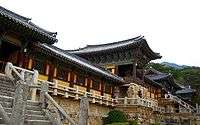Provisional Government of the Republic of Korea
| Provisional Government of the Republic of Korea | ||||||||||
| 대한민국 임시정부 (大韓民國臨時政府) | ||||||||||
| Government in exile | ||||||||||
| ||||||||||
| ||||||||||
| Motto "대한독립만세!" (Korean) "Long Live Korean Independence!" | ||||||||||
| Anthem "Aegukga"[1] | ||||||||||
| Capital | Hanseong 1945–1948 (de jure) | |||||||||
| Capital-in-exile | Shanghai 1919-1941 Chongqing 1941-1945 | |||||||||
| Languages | Korean | |||||||||
| Government | Presidential (1919–1925) Parliamentary (1925–1940) Presidential (1940–1948) (All 3 Formed a Provisional Government) | |||||||||
| President | ||||||||||
| • | 1919–1925 | Syngman Rhee | ||||||||
| • | 1927–1933 1935–1940 |
Yi Dongnyeong | ||||||||
| • | 1926–1927 1940–1948 |
Kim Gu | ||||||||
| Prime Minister | ||||||||||
| • | 1919–1921 | Yi Donghwi | ||||||||
| • | 1924–1925 | Park Eunsik | ||||||||
| • | 1944–1945 | Kim Kyu-sik | ||||||||
| Historical era | Early 20th century | |||||||||
| • | Nationwide civil resistance | 1 March 1919 | ||||||||
| • | Constitution | 11 April 1919 | ||||||||
| • | Government proclaimed | 13 April 1919 | ||||||||
| • | Hongkou Park Incident | 29 April 1932 | ||||||||
| • | War declared | 10 December 1941 | ||||||||
| • | Surrender of the Empire of Japan | 15 August 1945 | ||||||||
| • | Republic of Korea established | 15 August 1948 | ||||||||
| Currency | Won | |||||||||
| ||||||||||
| Provisional Government of the Republic of Korea | |
| Hangul | 대한민국임시정부 |
|---|---|
| Hanja | 大韓民國臨時政府 |
| Revised Romanization | Daehanmin(-)guk Imsijeongbu |
| McCune–Reischauer | Taehanmin'guk Imsijŏngbu |
Part of a series on the |
||||||||
|---|---|---|---|---|---|---|---|---|
| History of Korea | ||||||||
 | ||||||||
| Prehistory | ||||||||
| Ancient | ||||||||
| Proto–Three Kingdoms | ||||||||
| Three Kingdoms | ||||||||
|
||||||||
| North–South States | ||||||||
|
||||||||
| Later Three Kingdoms | ||||||||
|
||||||||
| Unitary dynastic period | ||||||||
|
||||||||
| Colonial period | ||||||||
|
||||||||
| Division of Korea | ||||||||
|
||||||||
| By topic | ||||||||
| Timeline | ||||||||
|
| ||||||||
The Provisional Government of the Republic of Korea was a partially recognized Korean government-in-exile, based in Shanghai, China, and later in Chongqing (then spelt Chungking), during the Japanese Korean period.
History
The government was formed on April 13, 1919, shortly after the March 1st movement of the same year during the Imperial Japanese colonial rule of the Korean peninsula.[2]
The government did not gain formal recognition from world powers, though a modest form of recognition was given from the Nationalist Government of China and a number of other governments, most of whom were in exile themselves.
The government resisted the colonial rule of Korea that lasted from 1910 to 1945. They coordinated the armed resistance against the Japanese imperial army during the 1920s and 1930s, including the Battle of Chingshanli in October 1920 and the assault on Japanese military leadership in Shanghai in April 1932.
This struggle culminated in the formation of Korean Liberation Army in 1940, bringing together many if not all Korean resistance groups in exile. The government duly declared war against the Axis powers Japan and Germany on December 9, 1941, and the Liberation Army took part in allied action in China and parts of Southeast Asia.
During World War II, the Korean Liberation Army was preparing an assault against the Imperial Japanese forces in Korea in conjunction with American Office of Strategic Services, but the Japanese surrender prevented the execution of the plan. The government's goal was achieved with Japanese surrender on September 2, 1945, but they were not approved by other governments as a member of allied nations, who signed peace treaty with Japan in San Francisco.
The sites of the Provisional Government in Shanghai and Chongqing (Chungking) have been preserved as museums.
List of presidents
- Syngman Rhee (September 11, 1919 - March 21, 1925) - Impeached by the provisional assembly
- Yi Dongnyeong (June 16, 1924 - December 11, 1924) - Acting
- Park Eun-sik (December 11, 1924 - March 24, 1925) - Acting
- Park Eun-sik (March 24, 1925 – September 1925)
- Yi Yu-pil (September 1925)-Acting
- Yi Sang-ryong (September 1925 – January 1926)
- Yang Gi-tak (January 1926 - April 29, 1926)
- Yi Dongnyeong (April 29, 1926 – May 3, 1926)
- Ahn Chang-ho (May 3, 1926 - May 16, 1926)
- Yi Dong-nyeong (May 16, 1926 - July 7, 1926)
- Hong Jin (July 7, 1926 – December 14, 1926)
- Kim Koo (December 14, 1926 – August 1927)
- Yi Dongnyeong (August 1927 – June 24, 1933)
- Song Byeong-jo (June 24, 1933 - October 1933)
- Yi Dongnyeong (October 1933 - March 13, 1940) - Died in office
- Kim Koo (1940 - March 1947)
- Syngman Rhee (March 1947 - August 15, 1948) - Became the first president of South Korea, from July 24, 1948 to April 26, 1960
Gallery
 Photo for memorial of establishing Provisional Government of the Republic of Korea, 1919.
Photo for memorial of establishing Provisional Government of the Republic of Korea, 1919. The museum in Chongqing, China.
The museum in Chongqing, China.- Provisional Government of the Republic of Korea site in Shanghai.
- Taegeukgi in Provisional Government of site the Republic of Korea in Shanghai.
- Office of Kim Gu in Provisional Government of ROK, Shanghai.
See also
References
- ↑ https://listenonrepeat.com/watch/?v=IKxczNaIWaQ
- ↑ Sources of Korean Tradition, vol. 2, From the Sixteenth to the Twentieth Centuries, edited by Yŏngho Ch'oe, Peter H. Lee, and Wm. Theodore de Bary, Introduction to Asian Civilizations (New York: Columbia University Press, 2000), 336.

